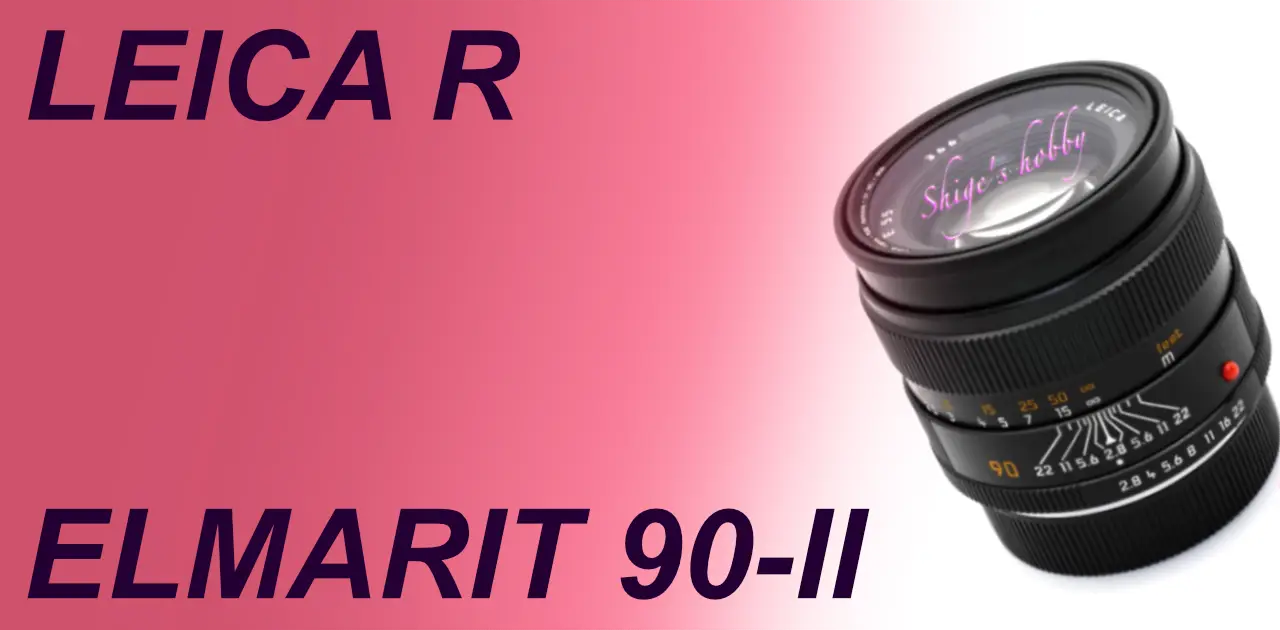Last updated on 2025-09-10
A review and sample photos of the Elmarit R 90mm F2.8 Type 2 lens used with SLR and mirrorless cameras.
- Please see the disclaimer regarding advertising here.
- Italicized links in the text are advertisement links that take you to other sites.
Table of contents

Gallery
- Sample photos were taken with LEICA SL Typ006 and CANON EOS 1Ds Mk-III.
Review


1.Overview
The ELMARIT R 90mm is a Leica R-mount medium telephoto lens with a focal length of 90mm.
The lens we are introducing today has a modern lens barrel design known as Type 2, with a unique feature being a single-section lens hood. When the hood is extended, the lens form remains almost cylindrical, giving it a simple, smooth design.
The main lens specifications are a four-element configuration in four groups, eight aperture blades, a minimum focusing distance of 0.7m, and a weight of 450g.
The lens mount also varies depending on the release date, but Type 2 lenses are either three-cam or R-cam, and some lenses can be modified to include a ROM terminal.
2.Usability
The ELMARIT R 90mm’s image quality is not as volatile as the Summicron at wide apertures, making it a reliable lens for use even at wide apertures. Along with the Elmarit R 28mm, it’s a lens for connoisseurs.
The focus ring has a rotation angle of approximately 270 degrees from infinity to 0.7m, which is standard for a manual focus lens. This angle allows you to focus carefully on the subject in manual focus mode.
With a bright f/2.8 lens, the viewfinder of a DSLR camera is not too dark, providing just the right amount of brightness. Focusing through the viewfinder of a Canon EOS 1Ds Mk-III was also easy.
Of course, with the mirrorless LEICA SL Typ601, you can use the magnified display in the electronic viewfinder for even more precise focusing.
3.Summary
In conclusion , to sum up, the ELMARIT R 90mm is a 90mm focal length lens that is lighter and smaller than the Summicron.
Like the other Elmarit lenses, it produces flawless and stable images from wide open aperture. Whether you consider this to be solid or boring is a matter of personal preference.
With a digital camera, the difference of half a stop is hardly noticeable, so if you don’t use the 90mm lens often, it makes a good budget lens to have on hand as a catch-all lens.
Specification and Competitor
Leica is a manufacturer that loves 90mm and 180mm focal lengths, and has released numerous lenses.
The ELMARIT R 90mm comes in two types: Type 1 and Type 2. Both have built-in hoods, but the barrel designs are different. Type 2 has a single-stage design, as explained in the overview, while Type 1 has a two-stage lens hood that creates a tapered shape when extended.
Also, among the Leica R-mount 90mm lenses, there are two higher-end models: the Summicron-R 90mm and the Apo-Summicron-R 90mm, both with a maximum aperture of f/2. However, since there is no Elmar 90mm for the R-mount with a maximum aperture of f/4, the Elmarit is the most entry-level lens. This contrasts with the M-mount, where the Elmar 90mm has been around since the early days of the Leica M-series cameras.
The reason there’s no Elmar 90mm for the R-mount is thought to be that a 90mm focal length lens with an f/4 maximum aperture has a lens barrel that’s too thin, resulting in poor balance when mounted on the camera. Some early M-mount Elmar 90mm lenses can be converted to the R-mount via VISOFLEX, but when mounted, the lens tapers from the base to the tip, resulting in an unattractive shape.
Unlike rangefinder cameras, where the focal length variation is limited by the viewfinder frame, SLR cameras, by their very nature, determine the viewfinder’s visible range based on the lens attached, making it easier to create focal length variations. For this reason, the Leica R-mount offers the Macro-Elmar 100mm as an f/4 medium telephoto lens. This lens, along with the APO MACRO ELMARIT 100mm, forms part of the R-mount’s medium telephoto macro line. The 90mm is a lens for general photography, while the 100mm is a macro lens.
The minimum focusing distance for the R-mount Elmarit 90mm is 0.7m, while for the M-mount Elmarit 90mm is 1.0m, meaning the R-mount SLR version is 0.3m shorter.
This is because the R-mount SLR camera does not have the parallax problem that is an issue with rangefinder cameras, which will be discussed later, so the minimum focusing distance is 0.7m.
This is thought to be because the M-mount version takes into account the parallax problem, where the captured image is misaligned with the position seen in the viewfinder due to a misalignment between the lens position and the viewfinder position, and the rangefinder coupling range is 1m, which is the same as the Barnack Leica.
| Lens name | ELMARIT | SUMMICRON | APO-SUMMICRON |
| Focal length(mm) | 90 | ← | ← |
| Max aperture | 2.8 | 2 | ← |
| Min aperture | 22 | 16 | ← |
| Leaf blade | 8 | ← | ← |
| Lens Construction | 4elements in 4group | 5elements in 4group | 5elements in 5group |
| Min distance(m) | 0.7 | ← | ← |
| Lens length(mm) | 61 | 62.5 | 59 |
| Lens Max diameter(mm) | 66 | 70 | 70 |
| Filter size(mm) | 55 | 55 | 60 |
| Weight(g) | 450 | 560 | 520 |
| Production Number | 16,615 | 37,954 | 2,000 |
| Release date | 1978〜1994 | 1970~1995 | 2002~2005 |
Reference links
- http://www.l-camera-forum.com/leica-wiki.en/index.php/90mm_f/2.8_Elmarit-R_II
- All about the R-type Leica / Author: Shinichi Nakamura / Edited by Asahi Sonorama
- Canon Leica-R Compatibility Database
- SUMMICRON R 90mm・Shige’s hobby
- APO SUMMICRON R 90mm・Shige’s hobby
- MACRO ELMAR 100mm・Shige’s hobby
Afiliate links

Amazon Prime Sale
Update history
- 2025.8.26
- 2024.7.29
- 2023.12.10


Be First to Comment